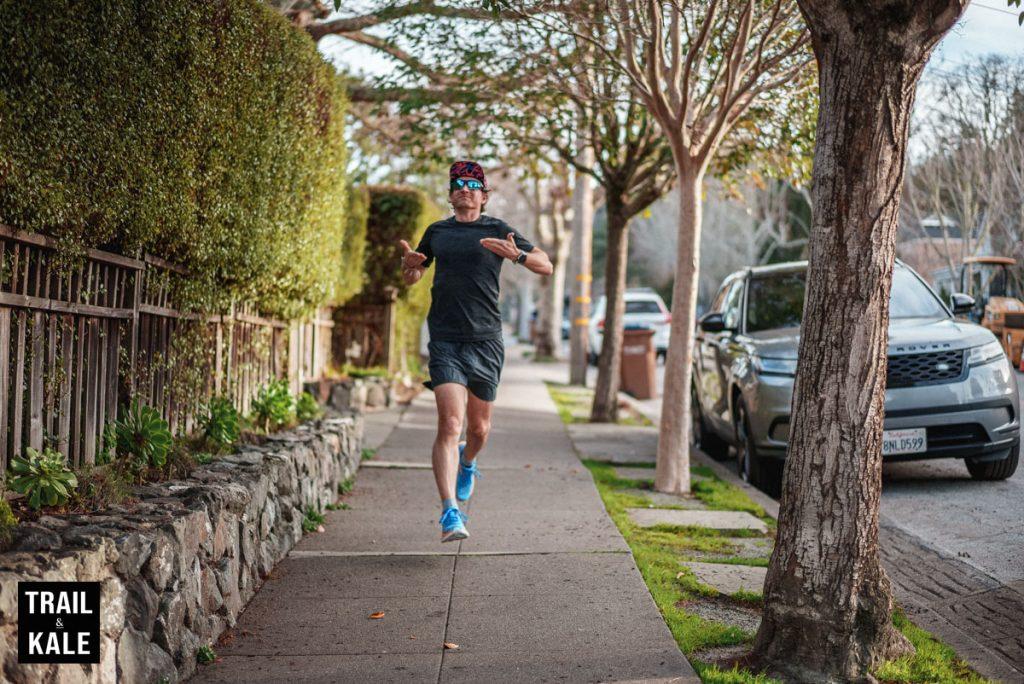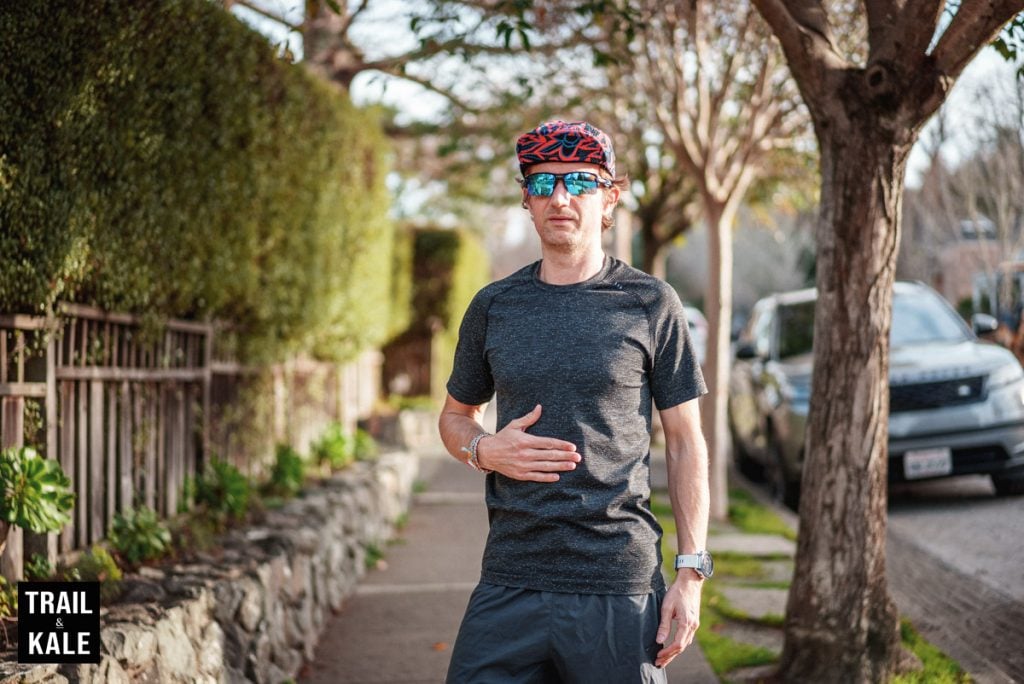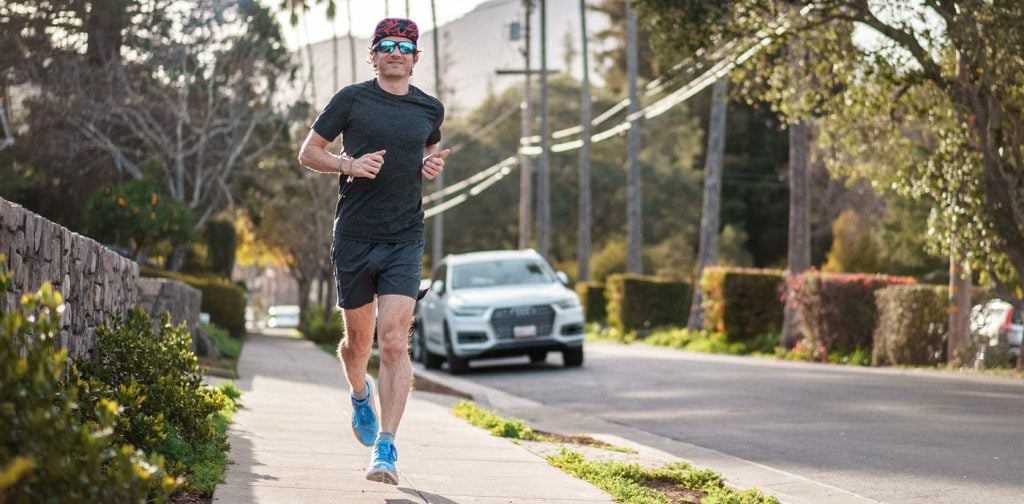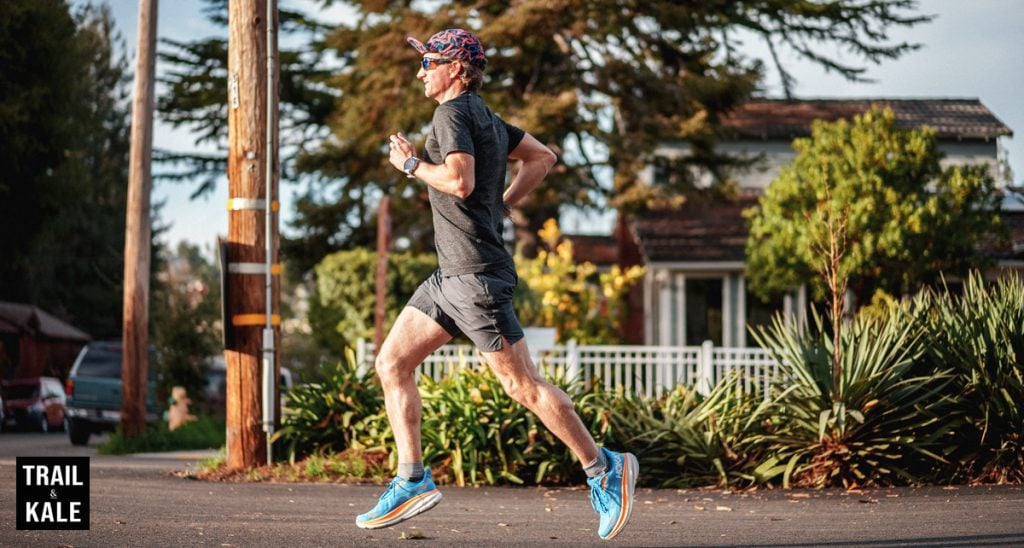In this post, I’m addressing the often-discussed topic of how to breathe while running. Breathing-related questions we at Trail & Kale hear all the time from both people who are new to running as well as experienced runners include:
- What is the proper breathing technique for running?
- How do you run without getting out of breath?
- How can I improve my breathing while running?
- Should you breathe through your nose or mouth when you run?
In this post, I explain what people actually mean when they talk about ‘proper breathing technique’ for runners, weigh in on the nose vs. mouth breathing debate, and cover two important techniques to learn to improve your breathing efficiency in everyday life as well as to maximize use of your lung capacity to help you run more easily and perform better.

The benefits to runners of breathing more efficiently
The two most obvious benefits of breathing properly when you run are the effect it can have on your running speed and endurance.
By breathing more efficiently, you can deliver more oxygen to your muscles, which can help you run for longer periods of time without feeling fatigued. It can also help you keep your heart rate down, maintain a steady pace and conserve energy, allowing you to run faster and longer.
In addition to maximizing oxygen intake for increased endurance and speed, having an effective breathing technique while you run has three other little-talked-about benefits:
Enhanced mental focus
There are reasons why breathing properly is so important for practices such as yoga and meditation.
It’s because – when done correctly – it can have many more benefits other than simply helping get oxygen into your lungs more efficiently.
By focusing on your breath, you can tune out distractions and become more present in the moment, which can improve your mood and help you enjoy your run more. This is one reason why many runners consider running to be a form of moving meditation.
Relating to this somewhat is that if you have a manageable breathing rate then you will also benefit from being able to eat running gels/energy chews without further needing to catch your breath after each mouthful while running – this is an art in itself! haha.
Improved recovery
Efficient breathing can help remove waste products like carbon dioxide from your muscles and deliver more oxygen, which can aid in muscle recovery.
Reduced risk of injury
When you breathe properly, you engage your core and other muscles, stabilizing your body and reducing the risk of running injuries as you’ll be better prepared to run with good form, which helps reduce your likelihood of suffering from issues such as shin splints and Achilles tendinitis.
Moreover, when you exhale fully, you help release tension and stress from your body, which can alleviate strain and soreness.
What is the proper breathing technique for running?
Breathing in our everyday lives is something most of us take for granted, it’s just something we do, often without thinking about it.
Before we get into the techniques, here are some breathing basics.

Breathing is, as you probably know, essentially how we get oxygen into our bodies and expel carbon dioxide.
When we run, we’re placing more stress on our bodies and need to increase our breathing rate and efficiency to get enough oxygen in, quickly enough, to remove the CO2 and try to reduce the amount of lactic acid that builds up in our muscles.
When we have too much lactate acid build-up, that’s when we start to experience fatigue and other issues such as muscle cramps.
So, when we talk about ‘what is proper breathing technique when running’, actually the primary goal that we’re trying to achieve is the most efficient breathing method possible to maximize oxygen intake.
How can I improve my breathing while running?
In this section I’m going to walk you through two breathing techniques that are beneficial for runners and should help you breathe more effectively and contribute to improvements in your running performance:
- Deep belly breathing: how to improve your breathing efficiency for running
- Rhythmic breathing: how to establish a breathing pattern as you run
1. Deep belly breathing: how to improve your breathing efficiency
Deep belly breathing, also known as diaphragmatic breathing, is widely regarded as the best way to develop more efficient breathing by getting more air into your lungs, compared to the typically relatively shallow breaths you may normally take out of habit.

This technique differs from what many people do to breathe normally, which is typically referred to as chest breathing, where you’re not using a large proportion of your lung capacity or putting additional effort into breathing closer to the body’s maximum oxygen intake.
Deep belly breathing technique involves breathing deeply and slowly, expanding your belly, and engaging your diaphragm to take in more oxygen. This technique is particularly useful for us as runners as it helps us breathe more efficiently, which in turn should mean less fatigue and enhanced performance as it should take longer to reach that lactate threshold.
To practice breathing in this way, inhale slowly and deeply through the nose, expanding your belly and filling the lungs with air.
To exhale, do so slowly, through your mouth, contracting your diaphragm and other core abdominal muscles to expel the air fully from the lungs.
By using abdominal breathing while you’re running, you can increase oxygen intake, reduce the risk of hyperventilation and improve your endurance. Belly breathing can also help you stay relaxed and focused, reducing the impact of stress on your body and mind.
To incorporate this technique into your running routine, it helps to first practice belly breathing when you’re not running, so your brain and your respiratory system get used to doing it, before gradually incorporating it into your running.
During a run, focus on breathing deeply and slowly, expanding your belly, and taking long, controlled breaths.
It’s also important that you pay attention to your posture, keeping your shoulders relaxed and chest open to allow for deeper breathing.
Yep, this is all a lot to think about, especially when you compare this breathing to how you would normally breathe, without any focus or thought! So, don’t worry if it takes time to get used to – it will take practice.
2. Rhythmic breathing: how to establish a breathing pattern
Rhythmic breathing essentially involves synchronizing your breathing with your footsteps.
This technique can help you regulate your breathing and maintain a consistent pace, which can be especially useful during interval training and tempo runs, as well as being a great way to get yourself into a more focused, meditative mindset for accomplishing a long training run or running consistently on race day.

A common example of rhythmic breathing for distance running at a steady pace is inhaling for three steps and exhaling for two.
Start breathing in when your right foot strikes the ground, run two more steps, then start breathing out over the fourth and fifth foot strike before repeating the pattern.
However, everyone is different and the right breathing pattern for you will depend on factors including your fitness level, running speed and run duration, as well as your personal preference.
Popular breathing patterns to try as you run include:
- Inhale for two steps, exhale for two steps
- Inhale for three steps, exhale for three steps
- Inhale for two steps, exhale for one step (usually better for shorter, more intense running efforts).
Experiment with different patterns until you find one that feels comfortable and allows you to maintain a steady pace.
How do you run without getting out of breath?
Applying a combination of diaphragmatic breathing and finding a rhythmic breathing pattern that works for you are two great techniques that will help you run more easily and be more prepared to run faster and longer without getting out of breath.
Additionally, both techniques can be useful if you tend to get a side stitch when running.
Deep belly breathing, on its own or in combination with mixing up your breathing patterns, can help prevent stitches, and get the pain to subside if you do get them.
In addition to ensuring you have good breathing techniques, working on improving your VO2 max (i.e. your aerobic capacity), increasing your lactate threshold and developing an efficient running form will also help you improve your running performance and enable you to run further and faster without getting out of breath as easily as you did before.
Should you breathe through your nose or mouth when running?

Research on nose breathing vs. mouth breathing is mixed.
Some studies (like this one) suggest that mouth breathing can quickly deliver more oxygen to the lungs, while other studies indicate that nose breathing is better at conditioning the air you breathe in.
Still, another study suggests that the choice between the two may ultimately come down to personal preference.
I’d like to see more research done in this area specifically as it relates to running performance, as all the studies I’ve seen have very small participant numbers, but what I’ve seen so far is largely aligned with what I would call common sense, given a basic knowledge of human physiology.
However, that said, here are some factors that will likely affect how you use your nose and mouth to breathe while running:
Nose blockages
If you have any issues with your nose that prevents you from using it to breathe in while running, for example, a past injury or surgery has affected it, then you may not be able to get as much airflow when attempting nasal breathing compared to mouth breathing.
Whether you’re running in a warm or cold climate
It can be downright painful to breathe in through your mouth in cold weather conditions, hence why many runners choose to breathe in through their nose, and out through their mouth.
Your nose warms and moistens air as it passes through, so it’s warmer and less shocking to your system when it reaches your lungs compared to air brought in with mouth breathing.
Your running effort level
If you’re sprinting or putting in a hard effort to run up a hill or running at altitude, then you’ll probably end up doing more mouth breathing to keep up with the sheer intensity of the effort you’re putting in, in an effort to get as much oxygen into your lungs as possible.
If you go out for a run aiming to run conservatively at a sustainable pace (for example if you’re training for a marathon and go out for your weekly long, slow run), then you should be able to comfortably use nose breathing (inhaling through your nose and exhaling through your mouth) to benefit from that nasal air conditioning described earlier.
Your weekly easy or recovery runs are also a good opportunity to practice these breathing techniques as you focus on your breath and form while you run at a pace that keeps you in easy, low heart rate zone.
What breathing method you’re used to
For example, whether you’ve always used both your nose and mouth to breathe during your runs, or if you’ve habitually used mainly mouth breathing.
Other environmental factors

As part of its work to ‘condition’ the air you inhale, your nose filters allergens and adds moisture to the air that passes through it as you breathe, which helps ensure the air reaching your lungs is not overly dry and is less polluted than air that’s entered your body through your mouth.
If you run somewhere with a lot of bugs such as flies and no-see-ums, then you’ll probably appreciate that there’s less chance of you swallowing bugs if you’re keeping your mouth closed (or almost closed) and using your nose to breathe in.
Whether or not you’ve read the book, ‘Breathe’
If you’re reading this thinking, well, I’ll always want to breathe through my mouth (after all it’s a bigger passageway for the air!), then I’d encourage you to read the book Breathe, by James Nestor – it could well change your mind, it changed ours!
This well-researched, thought-provoking book explores many aspects of breathing, including its connection to your overall health, well-being and – yes – athletic performance.
It certainly had a significant impact on how I think about the act of breathing and how your choice and application of breathing techniques can benefit, change or hinder your life more broadly, as well as specifically your athletic performance.
It offers some interesting insights into the mouth vs. nose breathing debate, which is relevant for people in their everyday lives as well as athletes trying to breathe better for running and other sports performance.
It also goes into the fascinating Wim Hof Method of breathing and also tummo breathing.
The Wim Hof Method is a breathing and cold exposure technique developed by Wim Hof, also known as “The Iceman”.
It involves a series of controlled breathing exercises and gradual cold exposure derived from the ancient Tibetan Tummo breathing and it aims to improve physical and mental well-being, increase energy levels, and reduce stress.
My take on nose vs. mouth breathing for running
All that said, in case you were wondering, my personal preference for breathing when running is to breathe in through my nose, and out through my mouth.
This works efficiently for me, offers the air-filtering and climate-controlling benefits of air coming in through my nose, and reduces the chances of me inhaling a bug or bee when I run. Not something you want to do in the middle of the forest during a long trail run, let me tell you (and don’t ask how I know!).
The exception to this is when I’m working REALLY hard on an uphill climb or during the end of a race, when I may switch to full-on mouth breathing in an effort to get as much oxygen into my body as quickly as possible for those more intense efforts!
I hope that this post has provided some useful insights into the best breathing techniques for runners to help you breathe more efficiently, deeply and easily when you run.
Do you have some favorite breathing techniques that you like to use when running? Let us know in the comments below!
